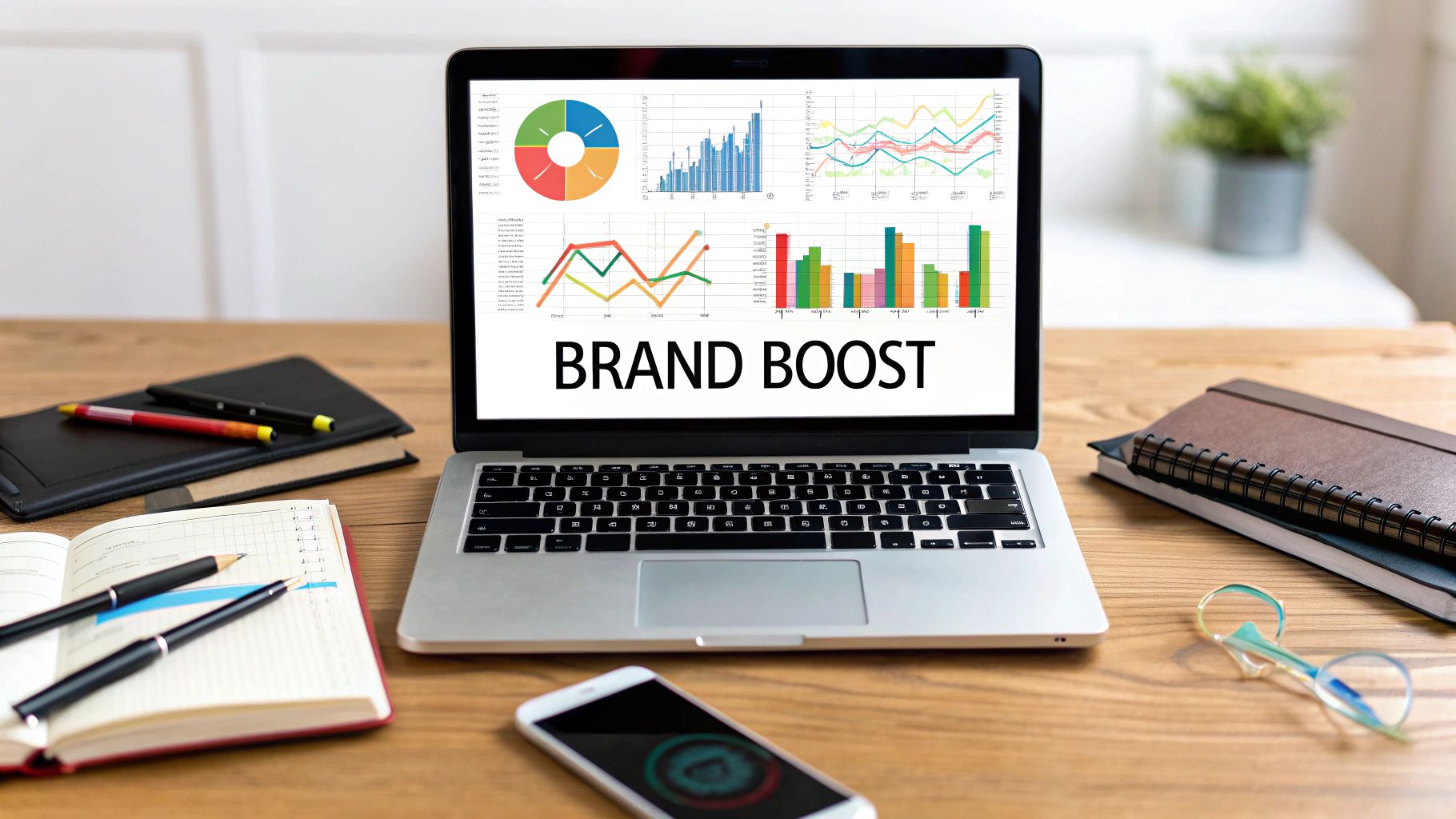In a competitive B2B SaaS market, brand awareness is more than just recognition; it's about becoming the default choice. A strong brand influences prospects long before they visit your website, shaping their perceptions through community discussions and search results. While many iconic campaigns come from the B2C world, the underlying principles of creating an emotional connection, demonstrating core value, and sparking conversation are directly applicable to B2B success. Forget surface-level success stories. This article deconstructs 8 legendary brand awareness campaign examples, translating their achievements into concrete strategies for B2B SaaS marketers.
We will move beyond simply admiring these campaigns. Instead, we'll dissect the specific tactics, strategic risks, and replicable frameworks behind their impact. You will learn how giants like Coca-Cola, Apple, and Spotify built unforgettable brands not just through big budgets, but through clever positioning and a deep understanding of their audience. Our goal is to equip you with actionable insights to develop campaigns that don't just get noticed, but build lasting brand equity. We will analyze how each campaign masterfully executed on key objectives, providing a blueprint you can adapt to make your own brand truly memorable.
1. Coca-Cola's 'Share a Coke' Campaign
The 'Share a Coke' campaign is a masterclass in transforming a ubiquitous product into a personal experience. Launched in Australia in 2011, this initiative replaced the iconic Coca-Cola logo on bottles and cans with hundreds of the country's most popular names. The core idea was simple yet brilliant: encourage consumers to find their own names or the names of friends and family, thereby fostering a powerful personal connection and inspiring social sharing.
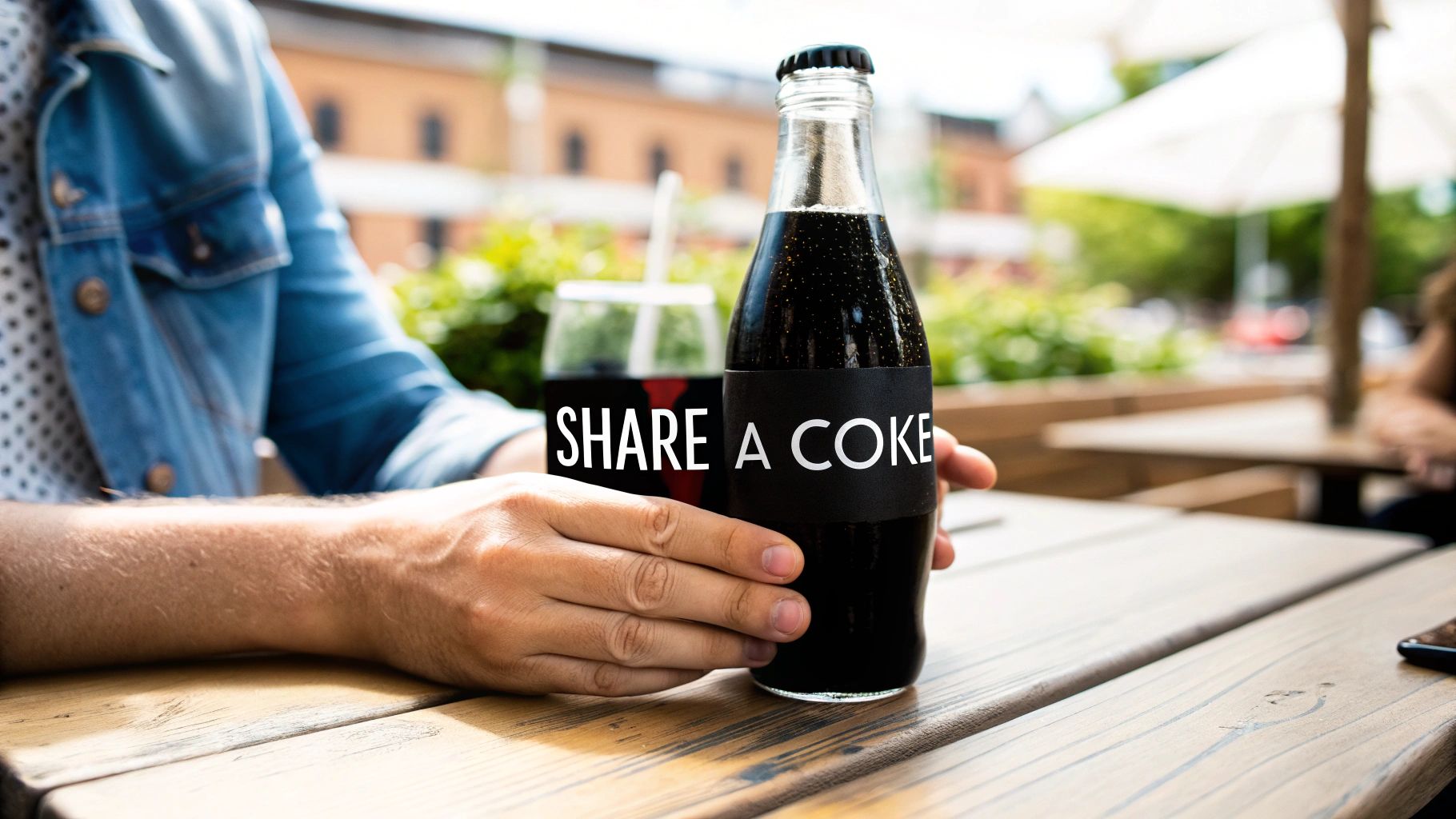
This strategy turned every bottle into a potential conversation starter and a piece of user-generated content waiting to happen. It tapped into fundamental human desires for identity, connection, and sharing, making it one of the most memorable brand awareness campaign examples in recent history. The campaign's success was staggering, leading to a 7% increase in consumption among young adults in Australia and eventually expanding to over 80 countries.
Strategic Analysis
The campaign's genius lies in its blend of mass production with mass personalization. It made consumers feel seen by a global giant, shifting the brand’s perception from a monolithic corporation to a personal friend. This was not just about putting names on a bottle; it was a carefully orchestrated omnichannel experience that combined physical products with a robust digital and social media strategy.
Key Insight: By temporarily sacrificing its most valuable brand asset-the logo-Coca-Cola created an even more powerful asset: a personal connection with millions of individual consumers, fueling organic, large-scale user-generated content.
Actionable Takeaways for B2B SaaS
While B2B SaaS companies don't sell physical bottles, the principles behind 'Share a Coke' are highly adaptable. The focus is on making your audience the hero of the story.
- Personalize at Scale: Use data to personalize onboarding experiences, marketing emails, or in-app messages. Address users by name and reference their specific usage patterns or company goals.
- Create 'Shareable' Moments: Design milestone badges, performance reports, or success summaries that users would be proud to share on professional networks like LinkedIn. For example, a "Power User of the Month" feature can encourage social proof.
- Leverage User-Generated Content: Launch a campaign encouraging users to share how your software has impacted their workflow or business. Feature their stories on your blog, social channels, or website to build community and trust.
2. Apple's 'Get a Mac' Campaign
Apple’s 'Get a Mac' campaign stands as a defining moment in comparative advertising, brilliantly simplifying the complex PC versus Mac debate into a relatable human interaction. Running from 2006 to 2009, the campaign featured actors personifying the two platforms: a cool, laid-back Justin Long as the Mac and a formal, problem-prone John Hodgman as the PC. The series of short, humorous ads directly addressed common PC frustrations like viruses, crashes, and overly complex systems.
This character-driven approach transformed technical specifications into personality traits, making the choice between computers feel like choosing a companion. The campaign’s simplicity and wit cut through the noise of tech marketing, creating a powerful narrative that positioned Mac as the superior, user-friendly alternative. Its cultural impact was immense, winning a Grand Effie award in 2007 and boosting Mac's market share significantly during its run.
Strategic Analysis
The campaign's success was rooted in its masterful use of brand personification and pain-point marketing. Instead of listing features, Apple created archetypes that embodied the user experience of each product. The PC character represented every frustration a Windows user might feel, while the Mac character embodied a smooth, creative, and hassle-free lifestyle. This strategy allowed Apple to highlight its rival's weaknesses without appearing overly aggressive, using humor as the vehicle for its competitive claims.
Key Insight: By personifying the competition's flaws and its own strengths, Apple created an emotional shortcut for consumers, making a complex purchasing decision feel simple and personal while solidifying its brand identity as innovative and user-centric.
Actionable Takeaways for B2B SaaS
The 'Get a Mac' strategy offers a powerful playbook for B2B SaaS companies looking to differentiate themselves in a crowded market, even without a TV-sized budget.
- Personify the Problem: Don't just list the features of your software. Create content (blogs, social posts, webinars) that personifies the "old way" of doing things-the clumsy spreadsheets, the inefficient workflows-as a relatable, frustrating character your solution can beat.
- Focus on User Pain Points: Like Apple addressed viruses and crashes, identify the top 3-5 frustrations your target audience has with competitor solutions or existing processes. Build your messaging around how your platform specifically solves these pains.
- Use Humor to Differentiate: B2B marketing doesn't have to be dry. Use clever humor in your ad copy, social media, or video content to make your brand more memorable and approachable. This can be particularly effective when comparing your modern solution to legacy systems.
3. Dove's 'Real Beauty' Campaign
The 'Real Beauty' campaign by Dove is a landmark example of purpose-driven marketing that fundamentally shifted the conversation around beauty standards. Launched in 2004, this initiative moved away from using professional models and instead featured real women of diverse ages, sizes, and ethnicities. Its core mission was to challenge conventional beauty ideals and foster a broader, more inclusive definition of beauty, thereby sparking a global dialogue about self-esteem.
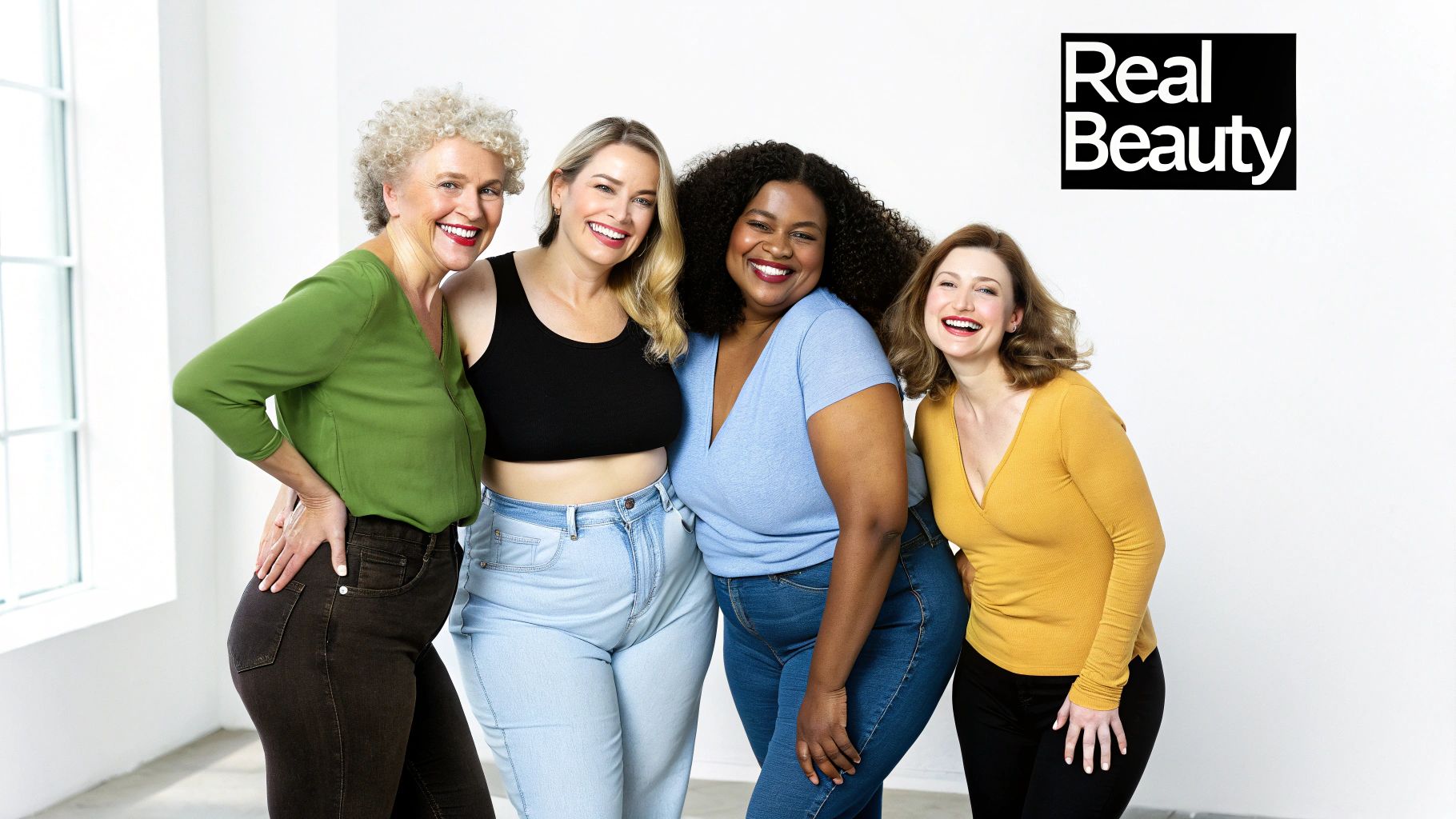
This long-term commitment transformed Dove from a simple soap brand into a cultural advocate. Viral videos like 'Evolution' and 'Real Beauty Sketches' became cultural touchstones, demonstrating the powerful emotional connection a brand can build when it stands for something more than its product. The campaign's success wasn't just in awards or views; it was in building a powerful brand identity synonymous with authenticity and empowerment, a masterclass in modern online reputation management.
Strategic Analysis
The campaign's brilliance lies in its authentic alignment of brand purpose with a deeply felt societal issue. By commissioning and publicizing research on beauty and self-esteem, Dove gave its campaign a foundation of credibility. This wasn't just advertising; it was a movement that invited women to participate in a conversation, positioning Dove as a facilitator rather than just a seller of beauty products. It masterfully used emotional storytelling to create a bond that transcended functional benefits.
Key Insight: By tapping into a genuine cultural tension and committing to a purpose beyond profit, Dove created a powerful brand platform that resonated on a deeply emotional level, fostering immense loyalty and differentiating itself in a crowded market.
Actionable Takeaways for B2B SaaS
B2B SaaS companies can adapt the core principles of the 'Real Beauty' campaign by aligning their brand with their customers' core professional values and challenges.
- Champion a Mission: Identify a larger issue within your industry (e.g., data privacy, work-life balance for remote teams, democratizing access to technology). Build content and community initiatives around this mission.
- Feature Real Customers: Instead of generic testimonials, create in-depth case studies or video series that showcase the real people behind the businesses you serve. Highlight their struggles, successes, and authentic experiences.
- Invest in Original Research: Commission studies or surveys on trends and pain points within your target industry. Publish the findings to establish your brand as a credible thought leader and conversation starter.
4. Red Bull's Stratos Space Jump
The Red Bull Stratos project was an audacious piece of experiential marketing that perfectly embodied the brand's slogan, "Red Bull gives you wings." In October 2012, Red Bull sponsored and broadcast Austrian skydiver Felix Baumgartner's record-breaking freefall from the stratosphere, 128,100 feet above Earth. This wasn't just an ad; it was a live, global scientific and sporting event that cemented Red Bull's identity as a facilitator of human achievement and extreme sports.
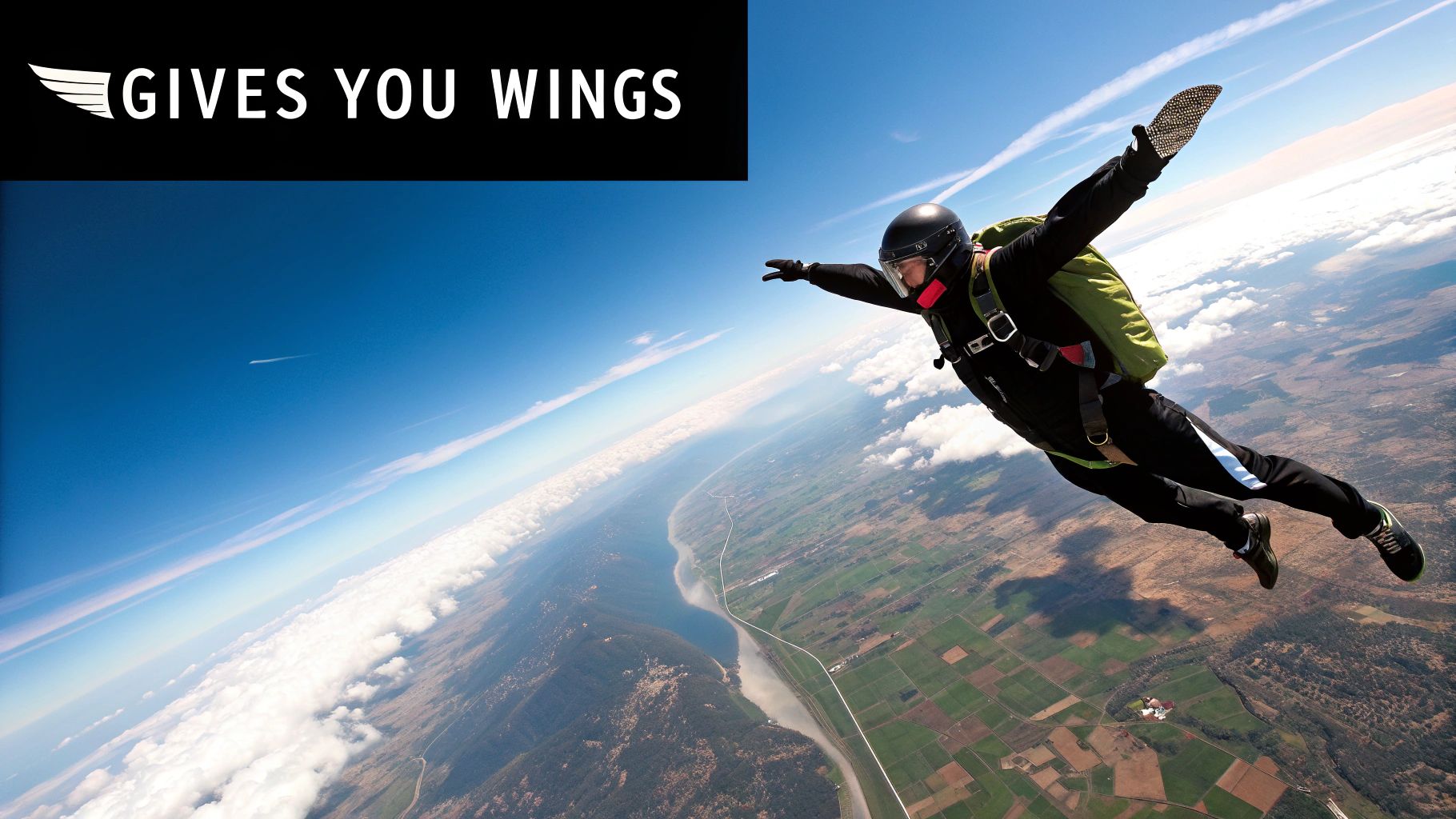
The event was a monumental success, watched live by over 8 million people on YouTube alone, a record at the time. It transcended traditional advertising by creating a genuine cultural moment that people wanted to watch and share. By producing an event so compelling that media outlets globally covered it as news, Red Bull generated earned media value far exceeding the project's cost, making it one of the most effective brand awareness campaign examples ever executed.
Strategic Analysis
Red Bull's strategy was to become the story rather than just sponsoring it. Instead of placing logos at someone else's event, they created their own historical moment that was intrinsically linked to their brand values of pushing limits and defying conventions. The brand was not an interruption to the content; the brand was the content. This approach allowed them to own the narrative completely, from the years of scientific preparation to the final, heart-stopping jump.
Key Insight: True brand awareness isn't about how many people see your logo; it's about creating an unforgettable experience that perfectly personifies your brand's core promise, turning your company from a sponsor into a publisher of must-see content.
Actionable Takeaways for B2B SaaS
While a space jump is out of reach, B2B brands can create their own "Stratos moments" by becoming a source of groundbreaking industry content or experiences.
- Publish Landmark Research: Instead of just another blog post, invest in a comprehensive, data-backed annual "State of the Industry" report. Make it the definitive resource that everyone in your niche cites.
- Host an Unmissable Virtual Event: Create a unique, high-production-value virtual summit featuring the biggest names in your industry. Focus on creating a genuine experience rather than a series of sales pitches.
- Launch a "Category Creation" Initiative: Develop and champion a new methodology or framework that solves a major industry problem. Document its development and share user success stories, positioning your brand as a thought leader and innovator.
5. Old Spice's 'The Man Your Man Could Smell Like'
Old Spice’s "The Man Your Man Could Smell Like" campaign completely redefined a legacy brand, catapulting it from the medicine cabinet of grandfathers to a viral cultural phenomenon. Launched in 2010, the campaign featured actor Isaiah Mustafa delivering a rapid-fire, hilarious monologue directly to the camera, seamlessly transitioning from a shower to a boat to riding a horse, all in a single, continuous take. The brilliant move was targeting women, the primary purchasers of men's body wash, with a message that was charming, confident, and absurdly funny.
This approach shattered expectations for the CPG industry. Instead of focusing on product features, it created pure entertainment that people actively sought out and shared. The campaign’s viral success was astronomical, with the initial ad gaining tens of millions of views and the brand's social media following exploding. It stands as one of the most effective brand awareness campaign examples for how to use humor and targeted messaging to achieve a complete brand overhaul.
Strategic Analysis
The campaign's success was rooted in a deep understanding of its target audience and a bold, channel-specific execution. By addressing women directly ("Hello, ladies"), Old Spice acknowledged who was actually making the purchasing decisions. The follow-up "Response Campaign," where Mustafa created nearly 200 personalized video responses to fans and celebrities on social media in real-time, was a groundbreaking use of interactive content that solidified the campaign's legendary status.
Key Insight: By shifting focus from the user (men) to the purchaser (women) and wrapping the message in shareable, high-production humor, Old Spice created content that wasn't just an ad but a piece of pop culture entertainment, generating unprecedented organic reach.
Actionable Takeaways for B2B SaaS
While B2B SaaS solutions aren't body wash, the strategy of targeting key decision-makers with engaging content is directly applicable.
- Target the Influencer, Not Just the User: Identify the key decision-makers or budget-holders in a buying committee. Create content like whitepapers, webinars, or ROI calculators that speak directly to their pain points (e.g., CFOs, CTOs), not just the end-users.
- Embrace 'Edutainment': B2B content doesn't have to be dry. Use humor, clever storytelling, or high-production video to make complex topics more engaging and memorable. A well-produced, witty explainer video can be far more shareable than a standard PDF.
- Plan for Real-Time Engagement: If you launch a major content piece or campaign, be prepared to engage with your audience in real-time. Monitor social media mentions and have a team ready to respond to questions, comments, and industry influencers to amplify your momentum.
6. Airbnb's 'Belong Anywhere' Campaign
Airbnb’s ‘Belong Anywhere’ campaign was a pivotal rebranding effort that masterfully shifted its narrative from a transactional service for affordable lodging to a global community built on human connection. Launched in 2014, the campaign introduced the new ‘Bélo’ logo, a symbol meant to represent people, places, love, and Airbnb itself, moving beyond the simple utility of renting a room. The core of the campaign was to celebrate authentic, local experiences and the community of hosts and guests.
This initiative repositioned the brand around the emotional benefits of travel-belonging and community-rather than functional ones. It was brought to life through documentary-style films featuring real host and traveler stories, and an interactive element where the community created over 40,000 customized versions of the Bélo symbol. This focus on user-centric storytelling is why it stands as one of the most powerful brand awareness campaign examples.
Strategic Analysis
The campaign’s triumph was its ability to ground a corporate rebrand in a universal human truth: the desire to belong. Instead of broadcasting a new corporate identity, Airbnb invited its community to co-create and define it. This transformed the rebrand from a top-down mandate into a bottom-up movement, fostering a sense of ownership and deep emotional investment among its users. The campaign was an exercise in building a brand platform, not just an identity.
Key Insight: By shifting focus from the 'what' (renting spaces) to the 'why' (creating a world where anyone can belong anywhere), Airbnb successfully elevated its brand above the competition, turning its user base into a powerful community of advocates.
Actionable Takeaways for B2B SaaS
The 'Belong Anywhere' ethos is profoundly relevant for B2B SaaS, where building a strong user community can be a key differentiator and a powerful engine for growth.
- Build a Community, Not Just a User Base: Frame your product as a platform that connects professionals. Host user-led webinars, create forums, or launch a Slack community where customers can share best practices and help each other succeed.
- Tell Authentic User Stories: Move beyond generic case studies. Create high-quality video testimonials or in-depth written profiles that showcase the human impact of your software on your customers' careers and businesses.
- Empower Brand Co-Creation: Launch a brand ambassador program or a user-driven content initiative. Encourage your most passionate users to create tutorials, share templates, or speak at events, making them co-owners of the brand's narrative. This is a core component of many effective B2B social media marketing strategies.
7. Nike's 'Just Do It' 30th Anniversary with Colin Kaepernick
Nike's 2018 campaign featuring Colin Kaepernick is a powerful example of how taking a bold, values-driven stance can generate immense brand awareness. The campaign, celebrating the 30th anniversary of the 'Just Do It' slogan, featured the former NFL quarterback with the tagline, "Believe in something. Even if it means sacrificing everything." This directly referenced Kaepernick's protests against racial injustice, which had made him a deeply polarizing figure.
The campaign was deliberately provocative, understanding it would alienate some customers while galvanizing its core audience. Despite initial boycott threats and a temporary stock dip, the move proved to be a strategic masterstroke. It generated an estimated $43 million in media exposure, sales jumped 31% in the days following the launch, and the campaign sparked a massive global conversation, reinforcing Nike’s brand identity as one that is courageous, inspiring, and culturally relevant.
Strategic Analysis
Nike's strategy was a calculated risk that demonstrated a deep understanding of its target demographic: young, diverse, and socially conscious consumers. Rather than appealing to everyone, Nike chose to resonate powerfully with a specific segment. The campaign aligned the brand's legendary slogan with a contemporary, high-stakes example of an athlete 'just doing it' for a cause greater than sports, moving beyond product to stand for a principle.
Key Insight: In a polarized world, taking a clear stance on a relevant social issue can be more powerful than neutrality. Nike proved that brand loyalty isn't just about product quality; it’s about shared values and emotional connection, which can turn customers into passionate advocates.
Actionable Takeaways for B2B SaaS
While B2B brands may operate in less controversial arenas, the principle of values-driven marketing is highly applicable. It's about demonstrating what your brand stands for beyond its software features.
- Define and Live Your Values: Clearly articulate your company's core values. This could relate to sustainability, data privacy, customer empowerment, or diversity in tech. Ensure these values are reflected in your product, company culture, and marketing.
- Target a Niche with Conviction: Instead of trying to be the solution for everyone, identify the segment of the market that shares your core values and speak directly to them. This builds a more loyal and engaged customer base.
- Create Value-Aligned Content: Launch a content series, podcast, or report that champions a cause relevant to your industry and audience. For example, a cybersecurity firm could advocate for digital rights and privacy, building brand equity as a trusted protector.
8. Spotify's 'Wrapped' Annual Campaign
Spotify's 'Wrapped' is a quintessential example of data-driven marketing transformed into a cultural event. Launched in 2016, this annual campaign provides users with a vibrant, personalized summary of their listening habits, including top artists, genres, songs, and total listening time. It masterfully leverages personal data to create unique, highly shareable content that users eagerly post across social media platforms.
The following bar chart visualizes the massive social engagement generated by the campaign, comparing the number of user shares to the resulting Twitter impressions.
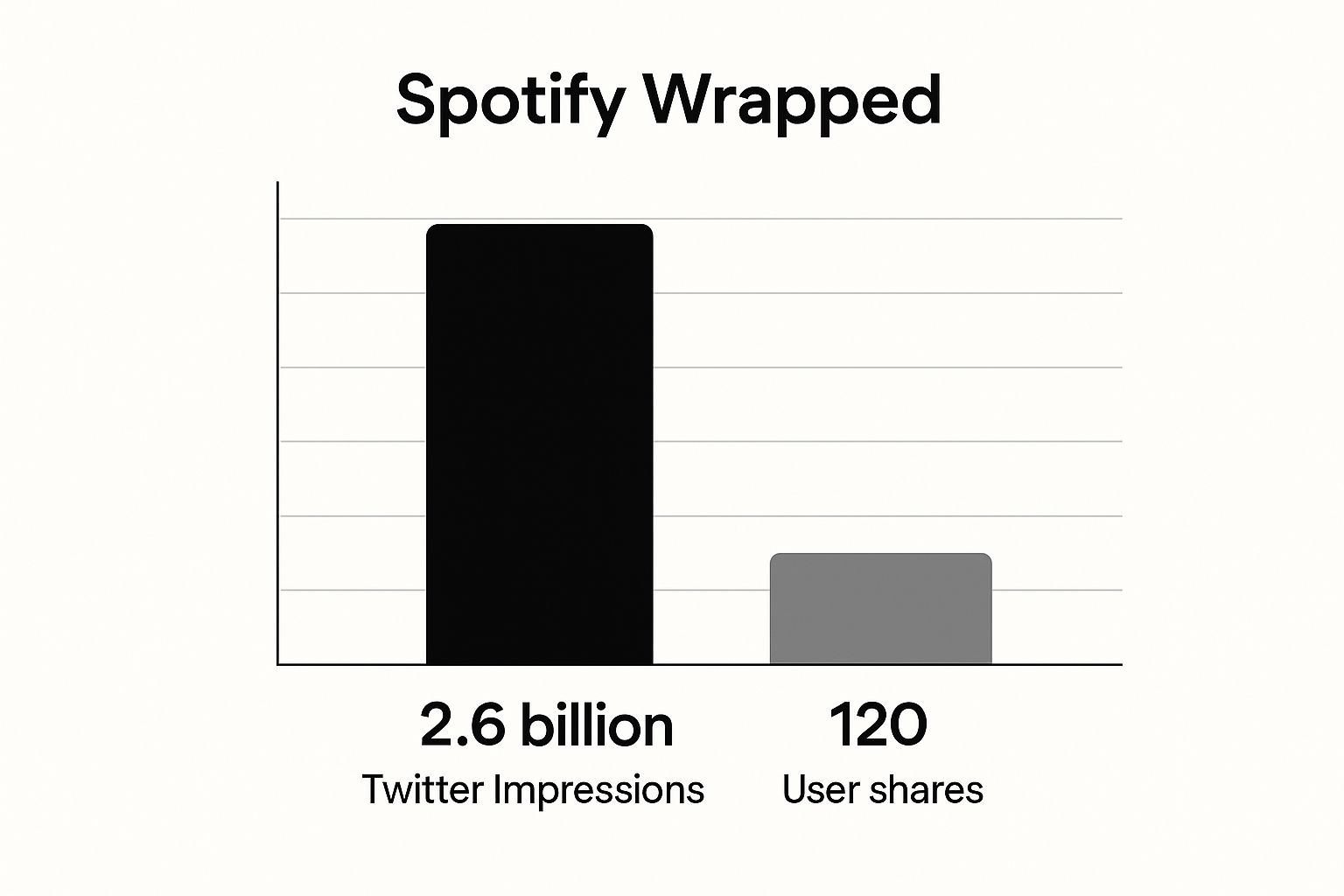
This data highlights how a finite number of shares can create an exponential ripple effect, turning millions of individual user posts into billions of organic brand impressions. This strategy has cemented 'Wrapped' as an anticipated yearly tradition, making it one of the most effective brand awareness campaign examples powered by user-generated content.
Strategic Analysis
The campaign's success stems from its ability to turn individual user data into a collective, celebratory experience. It fosters a sense of identity and community, allowing users to express their personality through their music taste. By designing the experience for mobile-first sharing and creating a sense of FOMO (fear of missing out) with its limited-time availability, Spotify guarantees a concentrated burst of brand visibility each December. Understanding how to track this virality is key; learn more about measuring marketing campaign effectiveness.
Key Insight: Spotify transformed a simple data report into a status symbol and a cultural moment. It gives users a valuable, personalized asset they are proud to share, effectively turning its entire user base into a powerful, organic marketing force.
Actionable Takeaways for B2B SaaS
The 'Wrapped' model offers a powerful blueprint for B2B SaaS companies to leverage their unique data assets for brand growth.
- Create Personalized User Reports: Develop an annual or quarterly "year-in-review" for your users. Highlight key achievements, usage milestones, or productivity gains they've made using your platform.
- Design for Professional Sharing: Format these insights into clean, shareable graphics optimized for LinkedIn. A report showing "You closed 35% more deals this quarter with our CRM" is powerful social proof.
- Incorporate Benchmarking: Allow users to see how their performance compares (anonymously) to industry averages or top performers. This social comparison element sparks conversation and encourages sharing within professional circles.
Brand Awareness Campaigns Comparison Table
From Examples to Execution: Building Your B2B SaaS Brand
The journey through these iconic brand awareness campaign examples, from Dove's emotional resonance to Red Bull's stratospheric ambition, reveals a powerful, unifying truth. Success isn't about having the largest marketing budget or the flashiest ad spend. It's about forging a genuine connection through a deep, empathetic understanding of a target audience.
These campaigns didn't just sell products; they sold ideas, identities, and belonging. Apple didn't just sell computers; it sold innovation and creative rebellion. Airbnb didn't just list properties; it created a global community built on trust. For B2B SaaS marketers, the landscape is different, but the core principle remains identical: your brand must stand for something more than its feature set.
Distilling the Core Strategies for B2B SaaS
The common thread is the shift from interruption to participation. Instead of just pushing a message out, these brands pulled audiences in. They created content, experiences, and conversations that people wanted to be a part of. This is the new frontier for B2B brand awareness.
Key takeaways from these diverse examples include:
- Emotional Resonance: Like Dove's 'Real Beauty,' connect with your audience on a human level. B2B buyers are still people driven by challenges, aspirations, and frustrations. Address their core pain points with empathy.
- Data-Driven Personalization: Spotify's 'Wrapped' campaign is a masterclass in using user data to create a delightful, shareable experience. B2B SaaS companies can leverage product usage data to create insightful industry reports or personalized benchmarks that offer immense value.
- Bold Value Alignment: Nike’s campaign with Colin Kaepernick and Apple’s 'Get a Mac' series show the power of taking a definitive stance. Define what your brand stands for and don’t be afraid to challenge the industry's status quo. This is how you build a loyal following.
- Community and Conversation: The most powerful brand awareness campaign examples often transcend traditional advertising by fostering community. The goal is to become an indispensable part of your industry's conversation, not just a bystander.
Your Next Move: From Insight to Action
Translating these high-level concepts into actionable steps is the critical next phase. Don't try to replicate Red Bull's space jump. Instead, replicate their mindset: find where your audience's attention is and create something unforgettable for them there. For many B2B SaaS brands, that place is not a Super Bowl commercial; it's a niche online community, a specialized industry forum, or a subreddit where your ideal customers are asking for advice.
Your brand's voice needs to be present in these authentic, unscripted conversations. By providing genuine value, answering complex questions, and building authority in these digital spaces, you embed your brand in the customer journey long before they even consider a purchase. This is how you move from being a vendor to becoming a trusted partner, building awareness that is both deep and durable.
Ready to make your brand a central part of the conversation in communities like Reddit where your ideal customers are actively seeking solutions? PimpMySaaS specializes in building authentic brand authority and driving targeted awareness within these critical channels, ensuring you're seen and trusted by your next best customers. Discover how we can amplify your brand's voice at PimpMySaaS.
